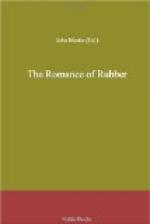Title: The Romance of Rubber
Author: John Martin (Ed.)
Release Date: December, 2003 [EBook #4759] [Yes, we are more than one year ahead of schedule] [This file was first posted on March 13, 2002]
Edition: 10
Language: English
Character set encoding: ASCII
*** Start of the project gutenberg EBOOK, the romance of rubber ***
Robert Rowe, Charles Franks and the Online Distributed Proofreading Team.
THE ROMANCE OF RUBBER
EDITED BY JOHN MARTIN
EDITOR OF JOHN MARTIN’S BOOK THE CHILD’S MAGAZINE
PUBLISHED BY UNITED STATES RUBBER COMPANY
AN INTRODUCTORY NOTE
We have undertaken to print this booklet, telling you how rubber is grown, gathered, and then made useful, for this reason:
The United States Rubber Company, as the largest rubber manufacturer in the world, wants the coming generations of our country to have some understanding of the importance of rubber in our every day life.
We hope to interest and inform you. We believe the rubber industry will be better off if the future citizens of our country know more about it.
CHAPTER 1
THE DISCOVERY
If you were asked, “What did Columbus discover in 1492?” you would have but one answer. But what he discovered on his second voyage is not quite so easy to say. He was looking for gold when he landed on the island of Hayti on that second trip. So his eyes were blind to the importance of a simple game which he saw being played with a ball that bounced by some half-naked Indian boys on the sand between the palm trees and the sea. Instead of the coveted gold, he took back to Europe, just as curiosities, some of the strange black balls given him by these Indian boys. He learned that the balls were made from the hardened juice of a tree.
The little boys and girls of Spain were used to playing with balls made of rags or wool, so you may imagine how these bouncing balls of the Indians must have pleased them. But the men who sent out this second expedition gave the balls little thought and certainly no value. Since Columbus brought back no gold, he was thrown into prison for debt, and he never imagined that, four hundred years later, men would turn that strange, gummy tree juice into more gold than King Ferdinand and Queen Isabella and all the princes of Europe ever dreamed of.




